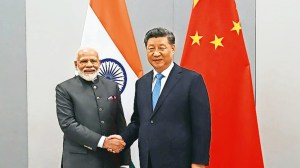A history lover traces ancient India’s contribution to board games and martial arts
The five-part series aims to explore the oft-overlooked contributions of ancient India to various fields of learning
 Window to Ancient India: A Tryst with Ancient Science & Philosophy | Part 1:
Chess, Board Games & Martial Arts
Satish S. Joglekar
StoryMirror Infotech
184 pages
Rs 250 (Source: Amazon.in)
Window to Ancient India: A Tryst with Ancient Science & Philosophy | Part 1:
Chess, Board Games & Martial Arts
Satish S. Joglekar
StoryMirror Infotech
184 pages
Rs 250 (Source: Amazon.in) Great contributions were made in ancient India in various fields of learning, including astronomy, mathematics, Ayurveda, yoga, philosophy, linguistics, grammar and others. Then, there is our great cultural wealth, spanning music, dance and literature. While we are aware of this, usually it is only scholars of ancient studies who know the details. The vast majority of us have to be satisfied with a sense of pride, while remaining ignorant about what those achievements really were. Satish Joglekar’s book fills this lacuna.
A senior information-technology professional with a degree from IIT Bombay, Joglekar has great interest in history and has set out to provide glimpses of ancient Indian wisdom in an accessible manner. He is not himself a professional historian or researcher, but has read deeply and his account is based on many sources through which he has enriched himself over the years.
The choice of topic in the opening volume of a series of five books is brilliant. Even though chess was invented in India, we had no presence on the international scene till the rise of Vishwanathan Anand. Now, we have more
than 75 Grand Masters, and many more titled players. Martial arts are, of course, very popular in the country, with classes in every residential locality. Yet, India’s contribution to the popular martial arts, thought to be from China, Japan or other Eastern countries, are less well-known. Exposing young readers to these contributions could get them to be interested in contributions in esoteric subjects such as mathematics and philosophy.
The first section of the book, devoted to board games, begins with the mention of Chaturanga in the Mahabharata and describes how the game first flourished in northwestern India and gradually spread across the subcontinent, undergoing many changes until it acquired its modern form. From India, the game travelled to Persia, then to Arabia, Spain and the rest of Europe. In the process, the name changed from Chaturanga to the Persian Chatrang to the Arabic Shatranj to the European Chess, the last being based on the Latin word “sacci”, which refers to the pieces used in the game. The author describes the evolution of the rules of the game over the centuries and its many variants, interspersing the discussion with interesting asides and anecdotes.
India also has a rich tradition of board games, some of which have been around for millennia. A mural in the cave temple of Ellora shows Shiva and Parvati playing chaupad, a game that also plays an important role in the Mahabharata.
All this and more are recounted in this section. Joglekar speaks of Ashtapada, described in his book Mahabhashya by the grammarian Panini; he also covers Pachisi and how the latter acquired the name Ludo in the West. There is also an interesting section on dice in this segment.
Joglekar begins the second section, devoted to martial arts, with references to Mushtiyuddha (boxing) and wrestling in the Rigveda, Ramayana and Mahabharata. From there, he moves to the Buddhist self-defence martial art
forms described in the Lotus Sutra. Knowledge of these arts was supposedly taken to China by the Buddhist monk Bodhidharma, who established the Shaolin monastery in Henan province, the seat of Kung Fu. China, in turn,
influenced martial arts in Japan. With the passage of centuries, India’s contribution was forgotten. Joglekar also describes popular modern forms such as kushti, malalkhamb, vetkhamb, kalaripayattu, thang ta, etc. Interestingly,
martial arts have influenced performing arts, and many dance forms include postures and stances from them. Joglekar discusses specific influences like those on Kathakali by Kalaripayattu. Both chapters end with useful
bibliographies.
As the author acknowledges, the book is not a product of research and is based on secondary sources. One of the motivations of the author in writing this book has been to bring to attention the many contributions of ancient India in diverse fields that are often neglected in Western descriptions. But Joglekar’s attitude is not parochial; he includes developments in other countries too, and cites scholars from different cultures and countries. The largely well-written book could have benefitted from some rearrangement of content, better design, layout and an index. Subsequent books in the pipeline could look into this.
Ajit Kembhavi is an astrophysicist and former director of the Inter-University Centre for Astronomy and Astrophysics, Pune
Photos


- 01
- 02
- 03
- 04
- 05




























